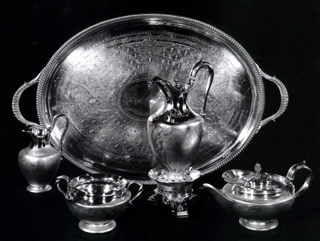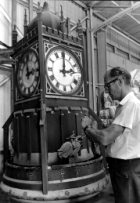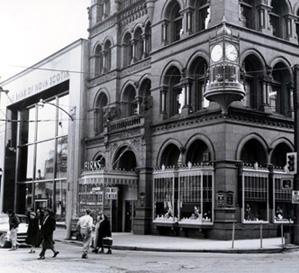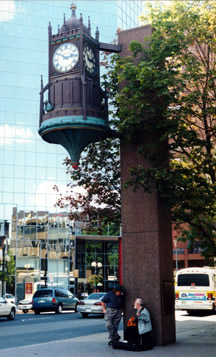2-6 King Street East
THE HEART OF THE CITY
BIRKS BUILDING
2-6 King Street East
The old red stone building at the southeast corner of King and James Streets became known as the Birks building in 1929. Prior to that the Canada Life Assurance Co., the Merchant's Bank, and the Bank of Montreal had occupied the building. Then it was bought by Henry Birks & Sons. Over the next decades, Birks would establish itself as a landmark store in Hamilton.Demolished in 1972
CURRENT STATUS (1999)
BUILDING INFORMATION
Date Built: Pre-1883; rebuilt after fire in 1929
Original Owner: Canada Life Assurance Co.
Original Use: Same
Subsequent Uses: Fidelity Management Ltd.ARCHITECTURE
Size: Five-storey
Architect, Builder: Architect Richard Waite of New York
Design and Style: Gothic
Construction Materials: Connecticut brown stone
Main Architectural Feature: Copper roof; display windows; charging horsemen clock
Henry Birks opened the first shop carrying his name in 1879. In 1893, his four sons joined the enterprise and the company’s name became Henry Birks & Sons. The chain of jewellery stores enjoyed much prestige, including a strong connection to the Royal Family. More than thirty years later, in 1929, Birks opened their first store in Hamilton. The Birks company had faith in Hamilton; in fact, by the 1950s, Hamilton was one of only three cities in Canada that had more than one Birks store.
 The Birks product was a source
of pride for Hamilton. Birks became a place for "discriminating seekers of fine
jewellery and unusual gifts." Every purchase made at the store was packaged in white
tissue paper with a silver seal embossed with the Birks logo. And the purchase was always
put into Birks’ signature blue box. Their campaigns ensured that "great moments
come out of the blue." It was not uncommon for people to buy less expensive jewellery
elsewhere and then wrap it in a Birks box before giving it as a gift. Obviously, Birks was
synonymous with high quality jewellery. Birks also sold Royal Doulton figurines, which
became very popular. When shopping, there were blue leather stools available for
discerning customers. Birks’ doors were open to people of all ages, all classes, and
there was always the smiling face of a knowledgeable sales person waiting to help. The
store managers were always active members of the community. Much later, when Birks was
affected by the recession and had to close all of its downtown locations, one saddened
customer remarked, "I feel like I’ve lost a friend."
The Birks product was a source
of pride for Hamilton. Birks became a place for "discriminating seekers of fine
jewellery and unusual gifts." Every purchase made at the store was packaged in white
tissue paper with a silver seal embossed with the Birks logo. And the purchase was always
put into Birks’ signature blue box. Their campaigns ensured that "great moments
come out of the blue." It was not uncommon for people to buy less expensive jewellery
elsewhere and then wrap it in a Birks box before giving it as a gift. Obviously, Birks was
synonymous with high quality jewellery. Birks also sold Royal Doulton figurines, which
became very popular. When shopping, there were blue leather stools available for
discerning customers. Birks’ doors were open to people of all ages, all classes, and
there was always the smiling face of a knowledgeable sales person waiting to help. The
store managers were always active members of the community. Much later, when Birks was
affected by the recession and had to close all of its downtown locations, one saddened
customer remarked, "I feel like I’ve lost a friend."
The building that housed Henry Birks and Sons is
perhaps of more importance than the Birks company itself. After a devastating fire in
1929, the Canada Life Building was going to be torn down but its owners decided to keep
it. Adding a copper roof, a canopy, show windows, the "Charging Horsemen" clock,
and a complete remodeling of the inside, restored the building. It became one of the
finest public buildings in the continent. George, Prince of Wales was given a tour of this
building during his 1883 visit to Hamilton, and Oscar Wilde thought it was the finest
building in America. The beauty of the  display
windows was not exceeded by any others, including shops in New York and Paris. But more
than its worldwide reputation, the Birks building gave Hamiltonians a sense of pride. The
downtown area was given fantastic character with the addition of the Birks Building.
display
windows was not exceeded by any others, including shops in New York and Paris. But more
than its worldwide reputation, the Birks building gave Hamiltonians a sense of pride. The
downtown area was given fantastic character with the addition of the Birks Building.
The "Charging Horsemen" clock, which sat beside the Birks building, has always been a distinct Hamilton landmark. The clock was designed in England and modeled after the "Clock of the Charging Horsemen" built for Wells Cathedral in Somerset, England by a monk in the 14th century. Hamilton’s clock was made by Kruger Gray, one of the world’s foremost authorities on medieval art. The lower half of the clock represents a medieval castle, while the upper half represents the tower of a cathedral. The flag surmounting the tower bears the lilies of France and the lions of England. Near the lower part of the clock there are four figures of mounted knights in armor. At a quarter past each hour, the nights circle the castle twice and on the second time they engage in a mock duel. One group of knights fall backwards having been defeated, until the next hour when the battle happens again. The eighteen-foot tall clock was set going at ten o’clock a.m. on October 11, 1930, and became known as a popular downtown meeting place for most Hamiltonians.
The Birks building also housed the Hamilton Art
School from 1886 to 1890, when it moved to the second floor of the library. The school was
started by local businessmen to ensure that quality local schooling was available in fine
and applied arts. The  Ontario School of Art in Toronto, and the
Hamilton Art School, were the only prominent art schools in the province. People moved to
Hamilton from all across Ontario to study art at this fine institution.
Ontario School of Art in Toronto, and the
Hamilton Art School, were the only prominent art schools in the province. People moved to
Hamilton from all across Ontario to study art at this fine institution.
On September 1, 1972 it was formally announced that the old Birks building would be torn down to make room for a new 15 storey office tower. The new building would be owned by Fidelity Management Ltd. and Birks would move into a prime location within Jackson Square. According to Hugh Hendrie, Vice President of Fidelity Management Ltd., the old building was a mess and financially impossible to preserve. The wooden floors would catch on fire too easily, the plumbing was always eroding, the electrical system was inadequate for modern office equipment of the time, the building was not properly insulated, and the once high-tech elevator was no longer practical because the company could not afford to pay an operator. Protesting and picketing at the old building began at once. People did not want to lose the building that had given their downtown so much character. Many thought there would be nothing to make Hamilton distinct without this structure. But the protesting came too late and the public could not prevent the old Birks building from being demolished.
 Fortunately, the "Charging
Horsemen" clock was saved. After Birks moved to the mall, there was some talk that
they were planning on moving the clock to their head office in Montreal. A citizen
committee was started to keep the clock downtown and they were successful. Birks however,
did not want the clock affiliated with a building to which they were no longer attached.
The clock was removed from its original place in 1984 and reinstalled outside Jackson Square in 1986. The clock was absent from the downtown
for two years, during which time $70,000 was spent refurbishing it. The city paid $48,000
of that amount and Birks paid the rest. The repairs included sandblasting the exterior,
painting, and extensive work on the mechanical and electrical parts. Only two weeks after
the clock was put back into the downtown area, the plug was pulled. The charging horsemen
weren’t working properly. The clock was beginning to sag, causing the horsemen to run
into each other. The clock has had many problems since then, and has been repaired many
times. The "Charging Horsemen" clock still sits outside of Jackson Square,
although the horsemen no longer charge.
Fortunately, the "Charging
Horsemen" clock was saved. After Birks moved to the mall, there was some talk that
they were planning on moving the clock to their head office in Montreal. A citizen
committee was started to keep the clock downtown and they were successful. Birks however,
did not want the clock affiliated with a building to which they were no longer attached.
The clock was removed from its original place in 1984 and reinstalled outside Jackson Square in 1986. The clock was absent from the downtown
for two years, during which time $70,000 was spent refurbishing it. The city paid $48,000
of that amount and Birks paid the rest. The repairs included sandblasting the exterior,
painting, and extensive work on the mechanical and electrical parts. Only two weeks after
the clock was put back into the downtown area, the plug was pulled. The charging horsemen
weren’t working properly. The clock was beginning to sag, causing the horsemen to run
into each other. The clock has had many problems since then, and has been repaired many
times. The "Charging Horsemen" clock still sits outside of Jackson Square,
although the horsemen no longer charge.
In 1993, the recession took its toll on the Birks company. The Jackson Square location closed, leaving Limeridge mall as the only Birks location left in Hamilton. The debt-laden company had previously downsized its head office and closed 12 locations across Canada. They filed for bankruptcy court protection from creditors. Birks had been an anchor business to Jackson Square, but times changed, and expensive jewellery was no longer feasible for the consuming public. Birks had stood for tradition and elegance, but all that had changed when they moved from the ninety year old building on the corner of King and James Streets and became just another mall brat along with the rest of them. The old Birks building is something that many Hamiltonians still remember, and they still lament its loss.
See also: www.birks.com
REFERENCES:
Architectural Conservancy Newsletter (Hamilton
– Niagara), New Series #3. October 1972. Special Collections, HPL.
Clipping File – Hamilton – Clocks – Birks, Henry
and Sons Clock of the Charging Horsemen. Special Collections, HPL.
Clipping File – Hamilton –Jewellery Trade – Birks, Henry and Sons.
Special Collections, HPL.
Hamilton This Month. November 1990.
Special Collections, HPL.
MacCuaig, Stuart. Climbing the Cold White Peaks: A survey of artists in and from
Hamilton 1910 – 1950.
Hamilton Artists Inc., 1986.
Our Heritage Scrapbook, Volume 2. Special Collections. HPL.
The Herald, October 10, 1930. Special Collections. HPL.
